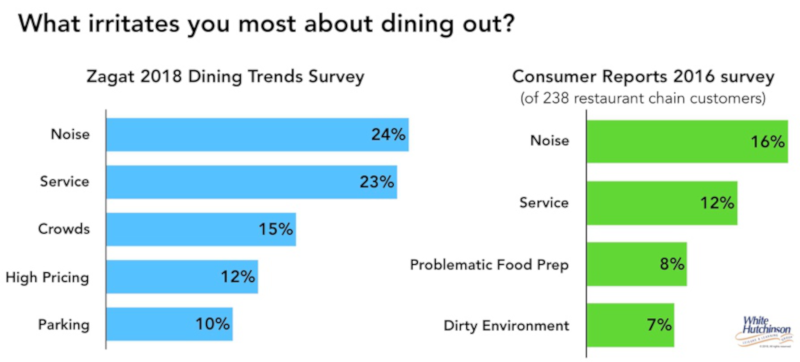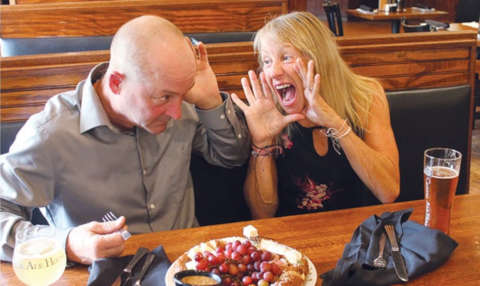
Vol. XVIII, No. 10, December 2018
- Editor's corner
- Is virtual reality the next BIG THING?
- Ocean5 wins Best New Center - Lounge/Restaurant design award
- Google is updating Maps as a B2C app
- Recent articles and in the press
- Construction cost increases challenging feasibility
- Most loved non-alcoholic drinks & their fastest growing flavors
- Home-basing - the new competition
- Miniature golf design for tomorrow
- A new generation of moms in on the way
- Willingness to spend time and money in a restaurant based on the noise level
- Update on the Tchotchke Index - what does it really tell us?
- eSports growing in popularity and coming to Walmart
- Trends reshaping dining out
Willingness to spend time and money in a restaurant based on the noise level
Both Zagat and Consumer Reports have found in their national surveys of restaurant diners that noise is the number one complaint.

Now, along comes a study, Lombard Effect In Restaurant Setting: How Much Would You Spend To Eat At This Restaurant? by Pasquale Bottalico at The University of Illinois to determine what excessive restaurant noise's impact is on guests' willingness to spend both time and money in a restaurant.

The study first determined the exact point when the noise in a restaurant causes vocal discomfort for guests, what is known as the Lombard Effect, when speakers unconsciously increase the loudness level of their speech in the presence of background noise in order to be understood. The study found that participants in the study started to be disturbed when the noise level became higher than 52 decibels (The normal level for conversation speech is 57 decibels). It was found that noise levels above 52 decibels start to decrease the willingness to spend time and money in a restaurant. The study recommended that restaurants should have background noise levels lower than 50-55 decibels to maximize revenues.

As the study shows, excess noise has an impact on revenues. This is just as true in entertainment venues where people go to socialize and have conversations. It is notable that in the Consumer Report's survey of 238 national restaurant chains that Dave & Buster's rated as the 2nd worse chain based on irritations, with nearly one-third being customer complaints about the excessive noise level (32%).
Several other studies have examined noise levels in restaurants. One early study found an average noise level of 71 decibels. A 2009 study of eight typical modern restaurants in Boston found that the average decibel level was 78. A 2012 study examined 30 casual dining and fast food restaurants in the Orlando, Florida area when the restaurants were only 50% full (less noisy than when they are full). Noise levels were found to vary from a minimum of 58 decibels to a maximum of 97 decibels. The majority of the restaurants (21 of 30) had maximum levels between 75 and 85 decibels. At 75 decibels a speaker would have to SHOUT to be heard at three feet and won't be understood at all at sound levels above 78 decibels. Eight of the restaurants had maximum levels over 85 decibels. Forget about conversation at those restaurants unless you know sign language. And as for getting your order correct, good luck.
Restaurants, and yes also community leisure venues, with high levels of background noise, trigger a stress response in guests. Noise raises levels of adrenaline, norepinephrine and worse, cortisol, creating the sensation of anxiety and even fear. Not exactly the enjoyable experience we want guests to have.
Not only do noisy environments affect our conversation and mood, it also affects how food tastes. Research has found that the eaters perceived saltiness and sweetness as less intense when they ate the food in the presence of loud background noise or music, in contrast to when they ate it with little or no background noise. So, the flavors that the chefs are creating in the kitchen may very well not end up being what guests experience. And another study found that the loud environment that increases stress also drives unhealthy, comfort food choices. And when it comes to drinking, loud environments hinders our ability to perceive how much alcohol is in a cocktail.
Our company has measured the sound levels in many CLVs, including traditional FECs, and we've almost consistently found high levels, often 85 decibels and higher. That's comparable to the sound of a lawn mower or city traffic.
Acoustics is something our company pays a lot of attention to when we design our client's projects, as it affects attendance, spending and profitability. Our projects are cited by reviewers for their good acoustics.
A review by Sue Kidd at The News Tribune of the Table 47 restaurant which our company designed said, “For years, I've heard valid diner complaints. The first is that modern restaurant design bounces too much noise. My ears concur. . . Did I mention the restaurant is actually tolerable in the noise department?” A review of our Bamboola children's entertainment center in San Jose, CA in the San Jose Mercury News included, “White Hutchinson Leisure & Learning Group of Kansas City create a place where adults can take their kids without being driven crazy by the nois...”
Good acoustics is something that has to be designed into the project at the beginning. It can be very expensive, sometimes impossible, to correct an excessively noisy environment after it is built.
Vol. XVIII, No. 10, December 2018
- Editor's corner
- Is virtual reality the next BIG THING?
- Ocean5 wins Best New Center - Lounge/Restaurant design award
- Google is updating Maps as a B2C app
- Recent articles and in the press
- Construction cost increases challenging feasibility
- Most loved non-alcoholic drinks & their fastest growing flavors
- Home-basing - the new competition
- Miniature golf design for tomorrow
- A new generation of moms in on the way
- Willingness to spend time and money in a restaurant based on the noise level
- Update on the Tchotchke Index - what does it really tell us?
- eSports growing in popularity and coming to Walmart
- Trends reshaping dining out


